Phase of S.H.M
Phase of S.H.M: Overview
This topic covers concepts, such as, Amplitude of Oscillation,Period of Oscillation,Time Period and Frequency etc.
Important Questions on Phase of S.H.M
Electrons moving with different speeds enter a uniform magnetic field in a direction perpendicular field. They will move along circular paths, time periods of rotation will be :
Two particles executing SHM of same frequency and same amplitude meet at while moving in opposite directions. Phase difference between the particles is :-
A simple pendulum of length has a time period for small oscillations. A fixed obstacle is placed directly below the point of suspension, so that only the lower quarter of the string continues oscillations (see figure). The pendulum is released from rest at a certain point . The period of oscillation, assuming small angles, will be:
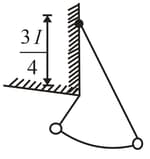
Equation of Displacement in SHM
The displacement of a pendulum for is correctly represented by
A conducting rod of mass and length is supported by conducting massless wires and carrying a current as shown in the figure. The rod is slightly displaced into the paper such that rod always remains parallel to -axis and released to perform SHM. If its time period is . Find the value of .
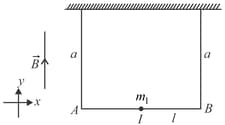
Calculate the value of '' at a place where a simple pendulum of length has time period (Take ).
Acceleration-time graph for particle starting from rest at is as shown in the figure. The particle has maximum speed at
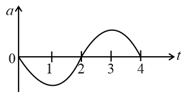
Draw the graphs to represent the
(ii) Variation of velocity with time for a particle undergoing SHM
Draw the graphs to represent the
(i) variation of displacement
(ii) Variation of velocity with time for a particle undergoing SHM
A semi cylindrical shell with negligible thickness oscillates without slipping on a horizontal surface. The time period of small oscillations is
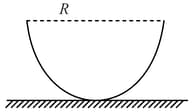
Imagine a helicopter hovering at a small height above a man standing on the ground. Helicopter rotor has two identical blades. Man is looking directly towards helicopter. We refer to the actual direction of rotation of blades as true direction. Assume human eyes takes "fifteen pictures" or frame per second.
Which one of the following is the correct acceleration vs. time graph for a particle performing SHM?
A cube of side and density is attached to a spring of constant partly submerged in a liquid of density as shown in figure. If the cube is slightly pressed and released then the frequency of oscillations is:
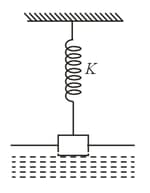
Where is the acceleration of the body performing SHM minimum?
Why acceleration is zero when velocity is maximum in SHM?
Why is velocity maximum at the extreme position?
Is acceleration maximum at extreme position in SHM?
When pendulum is at extreme position then acceleration is?
